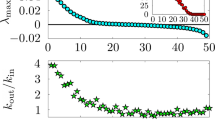Abstract
The cycle structure of enzymatic neural networks may be characterized in terms of number of cycles exhibited, size of cycle state sets and cycle lengths. Simulation experiments show that the stability properties of these networks have some unusual features which are not exhibited by networks of two-state switching elements or by randomly constructed ecosystem models. The behavioral and structural stability of these systems decreases with their structural complexity, as measured by the number of components. The behavioral and structural stability of enzymatic neural networks also decreases with structural complexity, as measured by the number of excitase types, but only up to the middle level of excitases per neuron. This is the point of highest potential responsiveness of the system to environmental stimuli. Beyond this point the behavioral and structural stability increase. This is due to the fact that the number of possible states increases up to this point and decreases beyond it. The number of possible states, not the number of components, serves as the useful measure of complexity in these types of systems. The selection circuits learning algorithm has been used to evolve networks whose cycle structures have desired features.
Similar content being viewed by others
Literature
Gardner, M. R., and W. R. Ashby. 1970. “Connectance of Large Dynamical (Cybernetic) Systems: Critical Values for Stability.”Nature, Lond. 228, 784.
Hastings, H. M. 1982. “The May-Wigner Stability Theorem.”J. theor. Biol. 97, 155–166.
Kampfner, R. and M. Conrad. 1983. “Computational Modeling of Evolutionary Learning Processes in the Brain.”Bull. math. Biol. In press. Wayne State University
Kauffman, S. 1970. “Behavior of Randomly Constructed Genetic Nets: Binary Element Nets.” InTowards a Theoretical Biology. 3. Drafts. Ed. C. H. Waddington Chicago, IL: Aldine.
May, R. M. 1974.Stability and Complexity in Model Ecosystems. Princeton, NJ: Princeton University Press.
McMurtrie, R. E. 1975. “Determinants of Stability of Large, Randomly Connected Systems.”J. theor. Biol. 50, 1–11.
Author information
Authors and Affiliations
Rights and permissions
About this article
Cite this article
Kampfner, R.R., Conrad, M. Sequential behavior and stability properties of enzymatic neuron networks. Bltn Mathcal Biology 45, 969–980 (1983). https://doi.org/10.1007/BF02458824
Received:
Issue Date:
DOI: https://doi.org/10.1007/BF02458824




